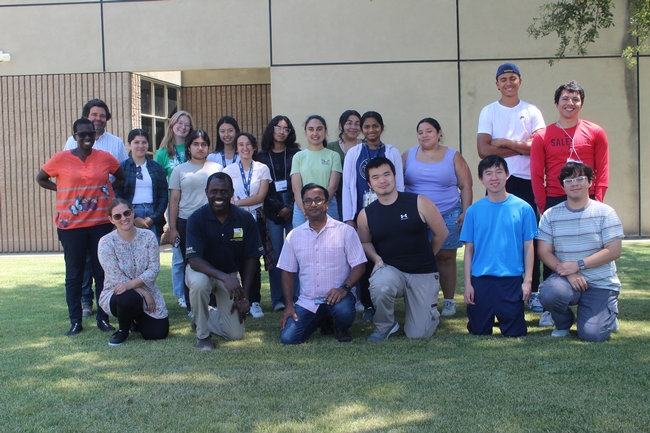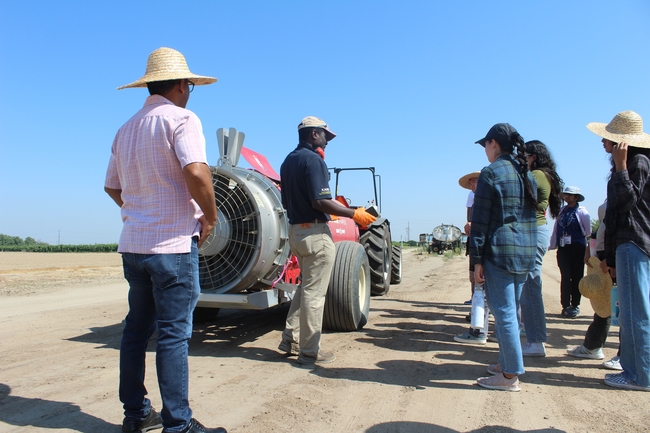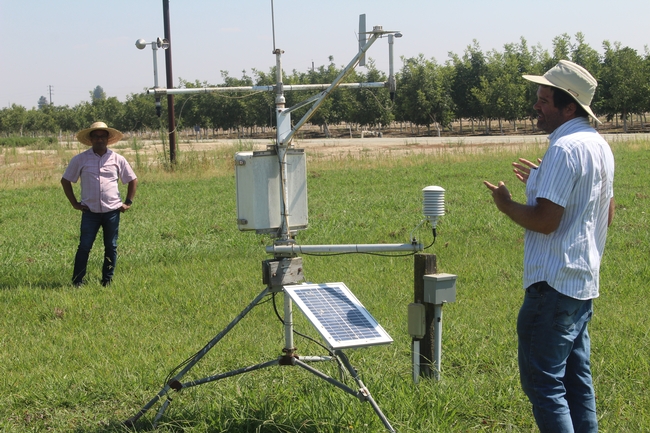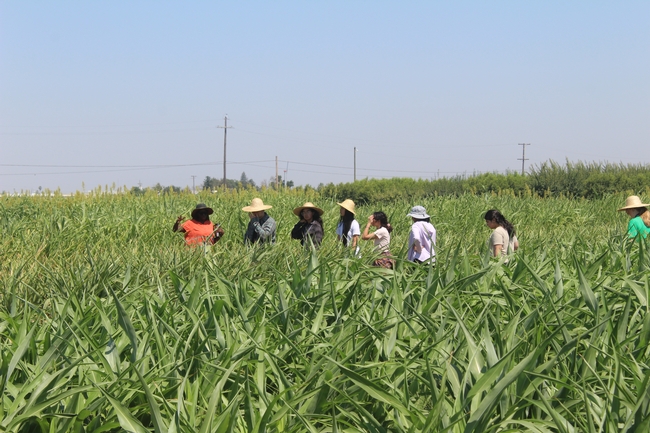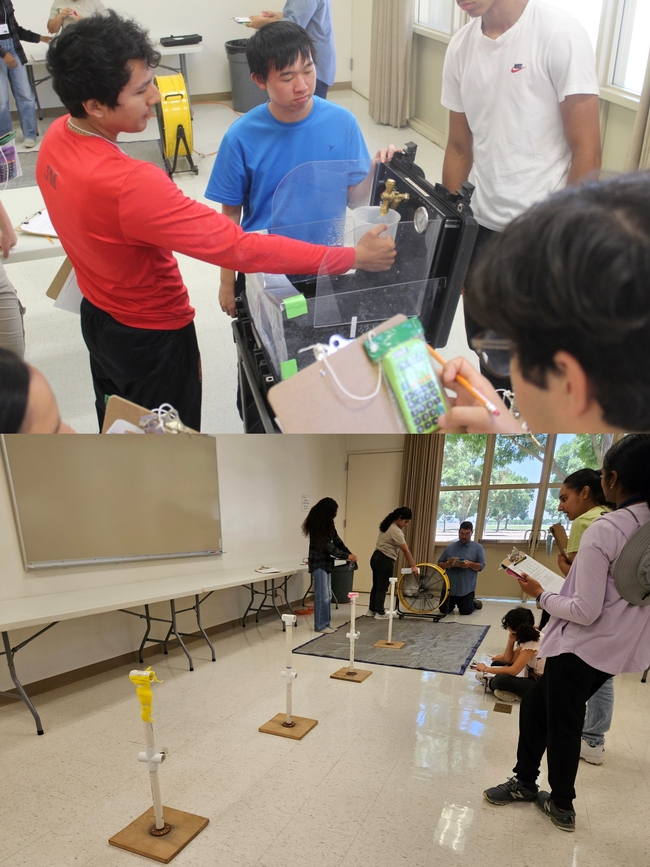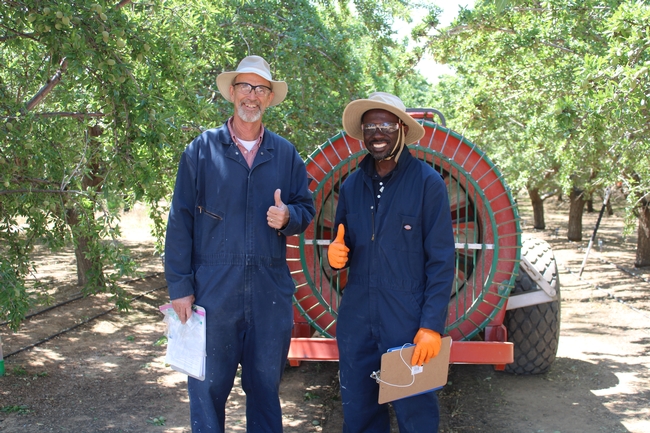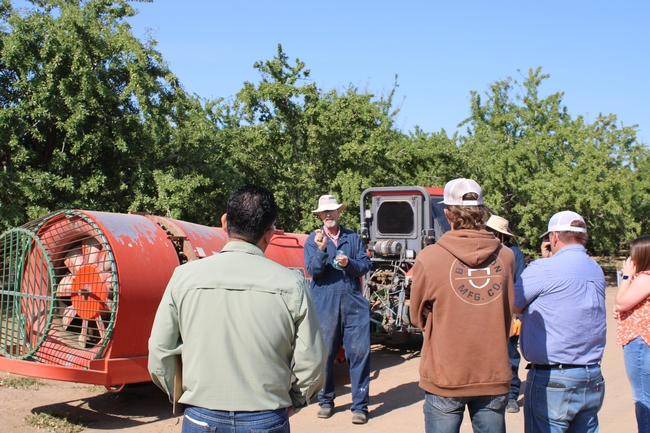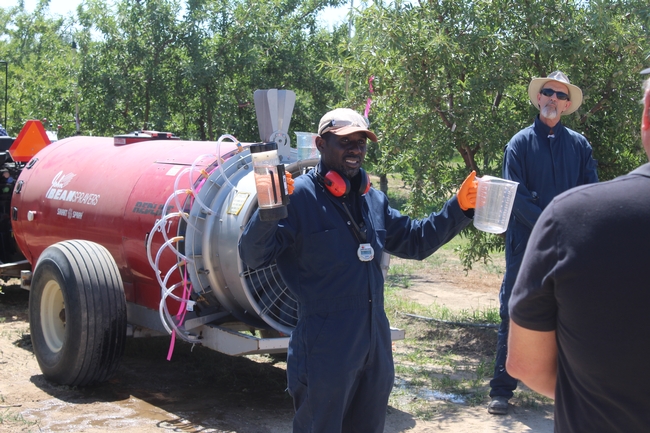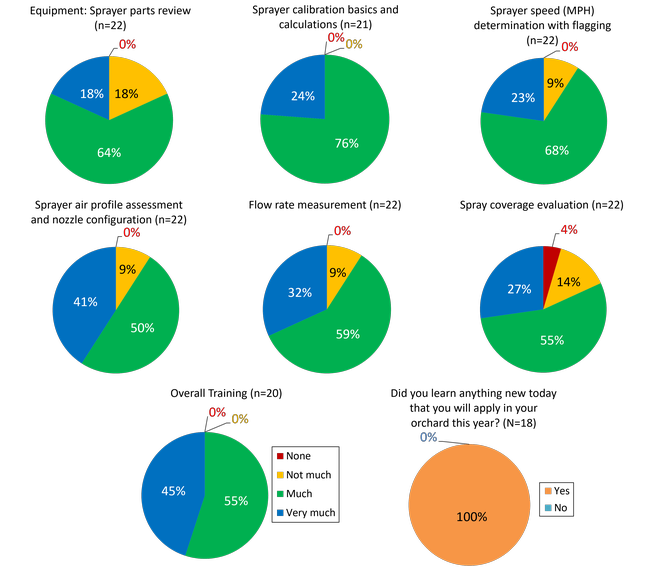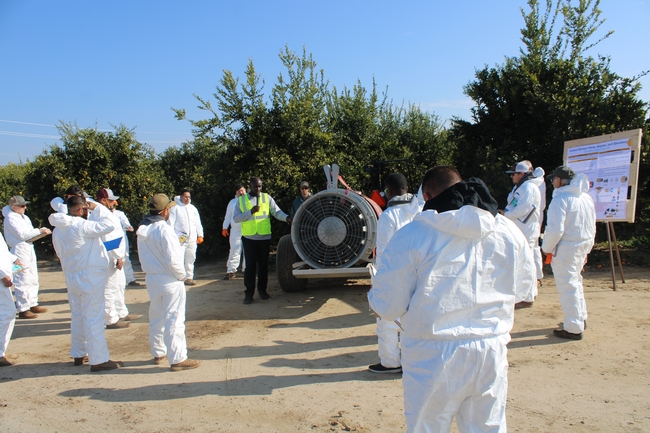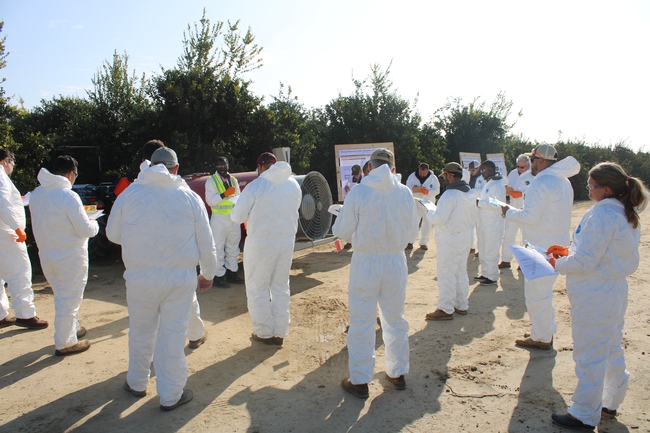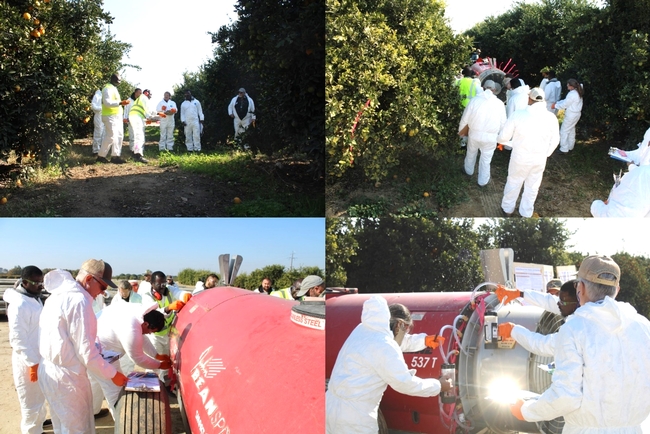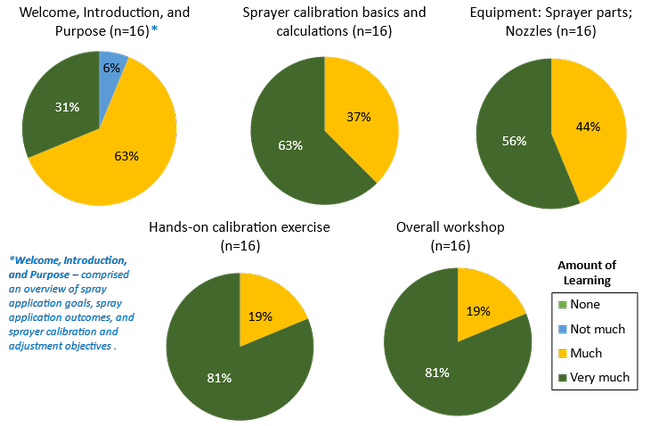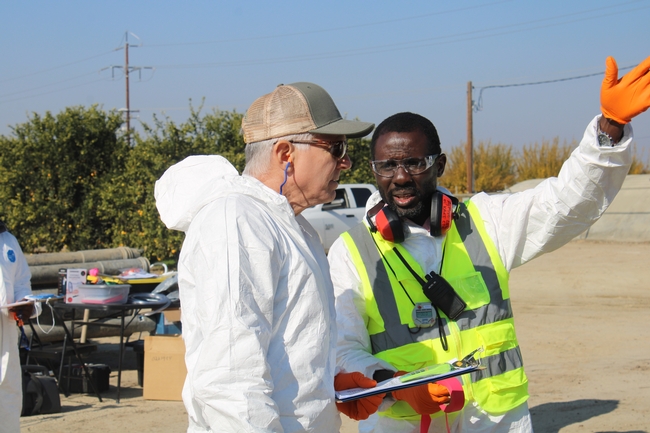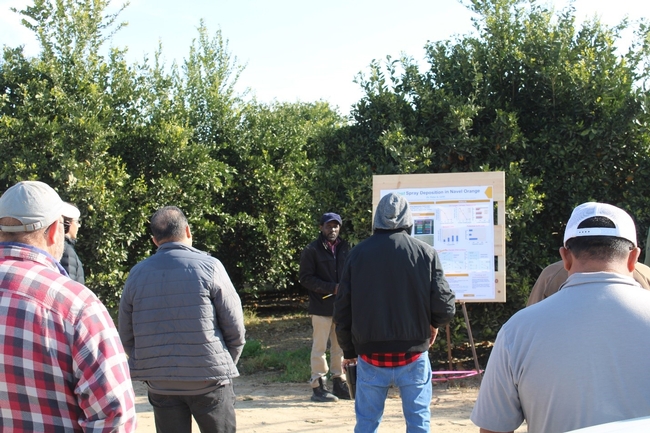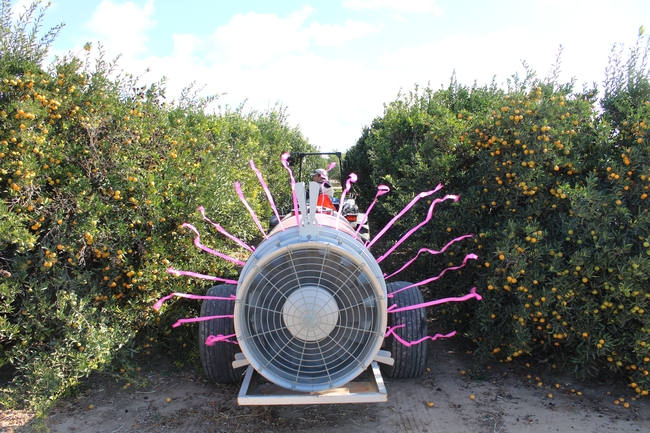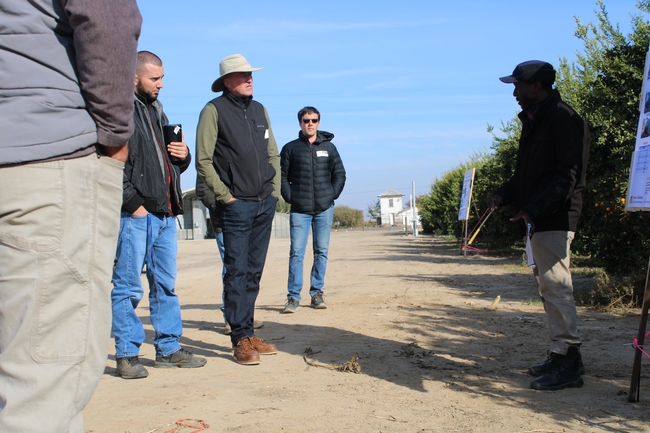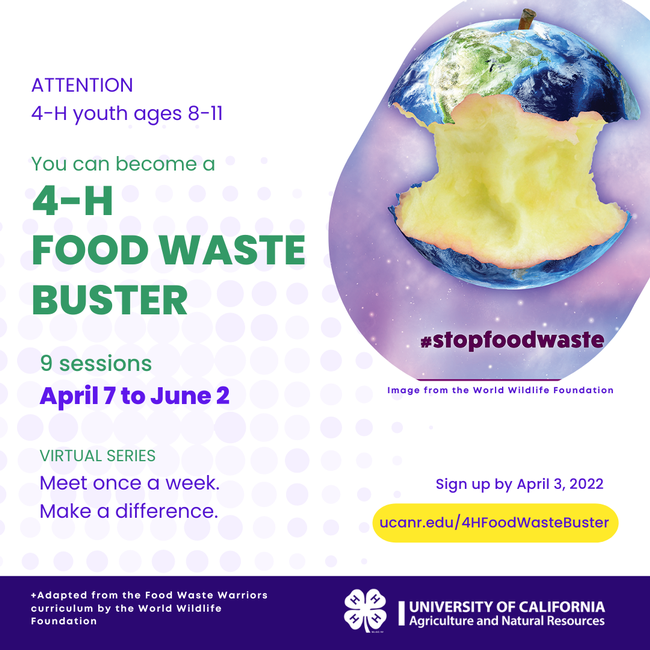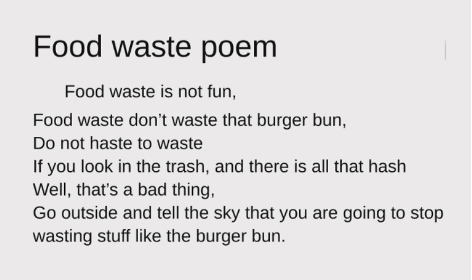- (Strategic Initiative) Sustainable Food Systems
- Author: Brady Holder
- Author: Peter Ako Larbi
- Author: Jackie Atim
- Author: Daniel Cabrera
Social media summary
Upon touring field research sites, listening to talks, and engaging in hands-on activities at the Kearney Agricultural Research and Extension Center, 100% of undergraduate students reported learning more about agricultural STEM research areas, which could steer them towards careers in agriculture.
The Issue
Students often lack awareness or appreciation of the existing relationships connecting agriculture and technology. For instance, students who are interested in emerging technologies may have never considered a career in agriculture. Conversely, students interested in agriculture may not have considered opportunities in research or practice involving technology. This tour sought to expose students to some examples of agricultural research involving technology to expand their knowledge of agriculture and the place of technology in agriculture-related research and practice.
How UC Delivers
In July 2023, UC ANR's Kearney Agricultural Research and Extension (KARE) Center hosted the 2023 cohort of students from the University of California Merced's San Joaquin Valley Food and Agriculture Cyberinformatics Tools and Science (FACTS) Bridge Program for a tour. The goal was to broaden the students' exposure to agricultural research and extension involving science, technology, engineering, and mathematics (STEM). The tour was also intended to provide the students with learning about technology and job opportunities in agriculture. The day was divided into two sections. In the morning, students went outside to visit field research sites and learned more about the specific projects underway. In the afternoon, students attended indoor presentations with hands-on activities. The 5.5-hour tour was presented collaboratively by UC Cooperative Extension Specialists Peter Ako Larbi, Jackie Atim and Bali Lab staff research associate, Brady Holder. Agricultural Application Engineering (AgAppE) Lab assistant Daniel Cabrera provided photography coverage for reporting. KARE Center staff also provided logistical and transportation support for the entire tour. The students were led by UC Cooperative Extension Specialist Safeeq Khan.
After being welcomed upon arriving at KARE, the students started the morning section. They were transported on a tram to the research fields, making stops at selected locations where they were hosted to presentations and demonstrations. The presentations/demos were given in an interactive format which allowed the students to engage with their observations, comments, and questions.
The first stop was by an almond orchard where Larbi provided an overview of pesticide spray application in orchards and vineyards, including the integration of emerging sensing and automation technologies for precision application. He also demonstrated airblast spray application in the almond orchard, placing water sensitive cards in a target tree canopy to demonstrate spray dispersion and coverage
The second stop was the California Irrigation Management Information System (CIMIS) weather station where Holder talked about how it is used to calculate crop water use. The presentation covered the various sensors employed and how they combine to measure evaporation rate as well as transpiration of the grass underneath the station.
The third stop was by Atim's sorghum plots where she talked about research into drought stress using sorghum, a drought tolerant and nitrogen efficient crop that is utilized as food, feed, forage, biofuel and bioproducts. Holder was able to demonstrate the use of drones in sorghum data collection.
The morning section ended with two additional stops hosted by Holder: one by a subsurface drip irrigation demonstration in tomatoes with a presentation covering how evapotranspiration values from CIMIS are used for proper irrigation scheduling to meet crop water needs and avoid waste; and another by alfalfa plots used to research deficit irrigation and groundwater recharge.
The afternoon section started with two spray hands-on activities intended for the students to become more familiar with the concepts of spray application. After a brief introduction by Larbi, the students were split up for two activities: 1) a nozzle flow rate measurement exercise; and 2) a spray dispersion demonstration exercise assisted by Cabrera. Atim and Holder further presented on research done at KARE center. The students completed evaluation forms at the end of the section/tour.
The Impact
A major goal of this tour was to increase knowledge of agriculture and use of technology in agriculture in California. A summary of the evaluations provided by student respondents are shown in the graphic below. On average, 88±10% reported gaining “much” or “very much” learning from the individual presentations on the tour. Lumped into the two sections, 86% and 90% gained such learning in the morning and afternoon sections, respectively. Overall, 100% of respondents reported such learning gains during the tour. During the tour, students learned about challenges and opportunities in California agriculture, which could potentially become a stepping-stone into career opportunities or research areas they might undertake themselves in their future.
Studies have shown bridge programs like this one increase first year overall grade-point average and university retention. Exposing students to research activities is particularly beneficial for encouraging students to enter and persist in STEM majors. Introducing incoming first-year students to ongoing agricultural research improves their awareness of agricultural STEM research and practice opportunities, a key step in not only increasing interest in and commitment to pursuing agricultural STEM majors but also careers in food and agriculture.
The FACTS summer bridge program will continue next year, when a new cohort of incoming first-year, second-year, transfer students, as well as returning second-year students visit the KARE Center to learn about agriculture, ag research, and technology.
- Author: Peter Ako Larbi
- Author: Franz J.A. Niederholzer
UC ANR supports California's almond crop protection workforce through Airblast Sprayer Calibration Trainings to maintain or improve their technical knowledge. 100% of participants reported both learning professional skills and their intent to adopt practices that can improve the sustainability and profitability of California ag.
The Issue
For efficient and effective pesticide spray application, all sprayers should be calibrated as often as necessary throughout the growing season of almonds, especially when dealing with orchards of different ages and sizes. Calibration is considered a best practice in pesticide spray application ensuring accurate application rates and adherence to pesticide labels which is the law. As such, proper understanding of sprayer calibration objectives and steps is needed to avoid using incorrect methods that give a false sense of accuracy. Educating growers and applicators in calibration methods will therefore empower them to ensure the use of properly calibrated sprayers well-adjusted to the target canopy to deliver maximum crop protection while minimizing pesticide loss.
How UC Delivers
In June 2023, UC ANR co-hosted two Calibration Safety & Compliance Training events, one for Northern California and the other for Central California, with the Almond Board of California (ABC), AgSafe Food and Farms (AgSafe), and the Western Agricultural Processors Association (WAPA). The Northern California training was held at the Nickels Soil Lab in Arbuckle, CA, while the Central California event took place at the UC's Kearney Agricultural Research and Extension (KARE) Center in Parlier, CA. The events were aimed at providing practical calibration training on how to prepare and calibrate airblast sprayers as well as compliance training such as how to manage required documents for pesticide applications. The 4.5-hour trainings included “Welcome” by the ABC, “Regulatory Update” by WAPA, “Calibration Training” by UC ANR, “Headquarters Compliance Training” by AgSafe, and “DPR Laws & Regulations Update” also by AgSafe. The DPR approved 4.0 hours of continuing education credits – 2.0 ‘Laws' and 2.0 ‘Other' – for qualifying participants. Overall, 50+ attendees participated in both events: 30+ in Arbuckle and 23 in Parlier.
The Calibration Training by UC ANR was a 2-hour practical session conducted in an almond orchard along with airblast sprayer demonstrations. It was presented in an interactive format allowing participants to interject with questions, comments, and observations. The Northern California training was led by UC Cooperative Extension advisor Dr. Franz Niederholzer in collaboration with UC Cooperative Extension specialist Dr. Peter Ako Larbi. Alternatively, the Central California training was led by Dr. Larbi in collaboration with Dr. Niederholzer. Both sections covered: “Sprayer parts review”; “Sprayer calibration basics and calculations”; “Sprayer speed determination”; “Sprayer air profile assessment and nozzle configuration”; “Flow rate measurement”; and “Spray coverage evaluation”. Staff from the Nickels Soil Lab, the Agricultural Application Engineering (AgAppE) Lab, and KARE Center provided Logistical, technical, and documentation support. The participants completed evaluation forms to provide feedback for just the Calibration Training section. Comments from the evaluation forms included…
“Very good class.”
“Great rapport with participants.”
The Impact
In all, 22 participants provided feedback on their learning for the combined Calibration Training sections for the Northern and Central California events. Overall, 100% reported “much” to “very much” learning from the combined Calibration Training sections indicating that they were very effective and provided participants with a great amount of learning. Likewise, 100% also indicated their intent to adopt the practices learned from the section. Looking at each section of the training, 82% reported learning “much” to “very much” from the “Sprayer parts review”, 100% the same for “Sprayer calibration basics and calculations”, 91% for “Sprayer speed determination with flagging”, 91% for “Sprayer air profile assessment and nozzle configuration”, 91% for “Flow rate measurement”, and 82% for “Spray coverage evaluation” (full breakdown of feedback by section in the graphic below). Additional written comments were mostly positive.
The needs assessment conducted by Dr. Larbi for his Agricultural Application Engineering Program in 2019 showed that 56% of perennial specialty crop growers and applicators in the San Joaquin Valley used airblast sprayers, 12% used tower sprayers, 15% used electrostatic mist blowers, and 17% used other sprayers. Also, 22% calibrated their sprayers 10 or more times a year, 32% calibrated 4-6 times, and 46% calibrated only 1-3 times a year. According to the California Pesticide Use Report, in 2021, 456,802 pesticide applications delivered 34,323,828 lbs. of pesticide across 24,147,968 acres of almond orchards. This amounts to 75.14 lbs. per application or 1.42 lbs. per acre. If even 1% of the application was overapplied and another 1% was underapplied due to using uncalibrated sprayers in the year (a conservative guess if nearly half of applicators only calibrate 1-3 years times a year), then 686,477 lbs would have been misapplied leading to either reduced pest control or increased pesticide loading on the environment. This number is very significant considering that the situation does not apply to only almond production. Thus, by increasing the competency of California's almond crop protection workforce for properly calibrating sprayers as a best practice, UC ANR potentially improved environmental sustainability.
UCCE academics Dr. Niederholzer and Dr. Larbi have an extended collaboration in providing spray application and sprayer calibration training in both Northern and Central California since 2019. The results presented here exemplify the impact of such trainings. Expanding this collaboration to include industry stakeholders reaches other audiences, potentially new participants, and increases the extent of impact. UC ANR will continue to support California agriculture through such trainings and the dissemination of science-based information to promote operational efficiency and profitability.
- Author: Peter Ako Larbi
UC ANR supports California's crop protection workforce to become more qualified through hands-on Airblast Sprayer Calibration Training. 100% of participants reported learning professional skills that also can improve the sustainability and profitability of California ag.
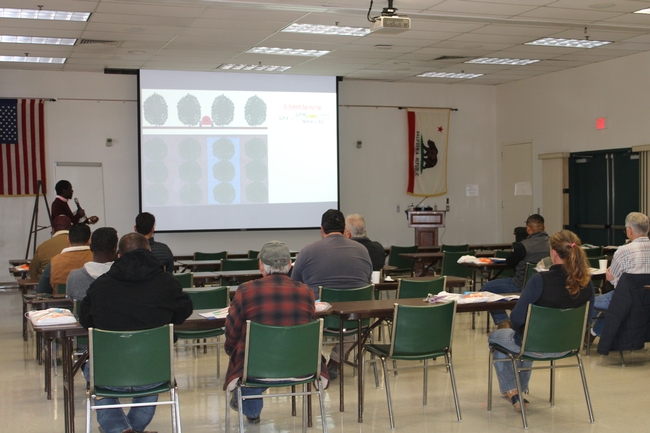
The Issue
As a best practice in pesticide spray application, growers and pesticide applicators should calibrate their sprayers to ensure accurate application rates and compliance with the law as represented by pesticide labels. However, proper understanding of sprayer calibration objectives and steps is needed to avoid a false sense of accuracy using incorrect methods. Educating growers and applicators in calibration methods will therefore empower them to ensure the use of properly calibrated sprayers well-adjusted to the target canopy to minimize pesticide waste and drift loss.
How UC Delivers
A half-day “Airblast Sprayer Calibration Training” was conducted in November 2022 at the Kearney Agricultural Research and Extension (KARE) Center. The in-person extension education event was supported by a California Department of Pesticide Regulation (DPR) grant. It involved classroom and field exercises focused on axial airblast spray applications directed to tree and vine canopies. The training was instructed by Dr. Peter Ako Larbi and assisted by his postdoc scholar Dr. Abiodun Abioye, with logistical support from his Agricultural Application Engineering (AgAppE) Lab and KARE Center personnel. It covered the basic steps and calculations involved in sprayer calibration, with practical follow up via hands-on demonstrations in the field. The DPR approved 3.5 hours of continuing education credits in ‘Other' category for qualifying participants. Sixteen participants were in attendance consisting of growers, applicators/operators, pest control advisors/certified crop advisors, scientists/researchers, and others.
The training started with classroom instruction covering “Welcome, Introduction, and Purpose” (comprising an overview of spray application goals, spray application outcomes, and sprayer calibration and adjustment objectives) and “Sprayer calibration basics and calculations” by Dr. Larbi. It then transitioned to in-field setting in a citrus block in an interactive format allowing participants to interject with questions, comments, and observations. With active participant involvement, the field experience included a presentation on “Sprayer Equipment Parts/Nozzles” by Dr. Abioye, hands-on exercises covering the calibration steps led by Dr. Larbi, a wrap-up discussion and answering of additional questions, and ended by evaluating participant learning. Engaging participants in various hands-on activities corresponding to the recommended calibration steps was intended to reinforce their learning. The spray equipment was operated by KARE Center staff research associate Ryan Puckett.
“Really helped me understand calibration much better.”
“Excellent speakers, demonstrators, trainers.”
The Impact
The participants were fully engaged throughout the training, and all (100%) provided feedback on their learning. Overall, those who reported gaining “much” to “very much” learning are: 94% for “Welcome, Introduction, and Purpose”; 100% for “Sprayer calibration basics and calculations”; 100% for “Equipment: Sprayer parts/Nozzles”; and 100% for “Hands-on calibration exercise”. On average, 97% reported gaining such learning in the classroom portion and 100% in the field. Overall, 100% reported “much” to “very much” learning from the entire training, indicating that it was very effective and provided participants with a great amount of learning. Additional written comments were mostly positive, and many participants verbally expressed their appreciation for the thoroughness of the training.
Dr. Larbi and his AgAppE Program plan to continue providing similar trainings in the future on both ongoing and need bases to arm his clientele with science-based knowledge and skills that will promote their operational efficiency and profitability.
According to the 2021 California Pesticide Use Report, 82,550,620 lbs. of pesticide was used in 941,751 applications for the top five (5) crops in all counties in the San Joaquin Valley covering 45,087,167 acres. Eighty-nine (89) percent of the quantity was applied on 39,742,883 acres of perennial specialty crops, which are the systems of primary focus for Dr. Larbi and his AgAppE program, amounting to 79.38 lbs. per application or 2.34 lbs per acre. Moreover, Dr. Larbi's 2019 Agricultural Application Engineering Program needs assessment revealed that only 22% of growers and applicators calibrated their sprayers 10 or more times a year, 32% calibrated 4-6 times, and 46% calibrated only 1-3 times a year. Hence, assuming a mere 1% of the application done in perennial specialty crop in 2021 was overapplied and another 1% was underapplied due to using uncalibrated sprayers, then 1,467,100 lbs would have been misapplied leading to either reduced pest control or increased pesticide loading on the environment. This number is very significant considering that the situation does not apply to only the top five crops. Thus, by increasing the competency of California's crop protection workforce for properly calibrating sprayers as a best practice, the AgAppE Program potentially increased workforce retention, improved environmental sustainability, and increased the profitability of growers.
- Author: Peter Ako Larbi
Upon attending the Citrus Spray Field Day in November 2022 at the Kearney Agricultural Research and Extension (KARE) Center, 93% of participants reported learning much or very much about spray application best practices, which can lead to increased agricultural efficiency.
The Issue
Because of the complex nature of spray application under field conditions, growers and pesticide applicators have difficulty in recognizing or using best practices that result in desired application efficiencies. Therefore, applications often fall short. Developing and disseminating science-based recommendations from field trials and decision support tools to assist with pesticide spray application decisions will reduce the guesswork, improve efficiency, and promote effective pest control.
How UC Delivers
The Citrus Spray Field Day was a 4-hour classroom and field meeting that discussed pesticide application effectiveness, focusing on axial airblast spray applications directed to citrus (and other tree and vine) canopies. It was instructed by Dr. Peter Ako Larbi with support from hisAgricultural Application Engineering (AgAppE) Lab andKARE Center personnel. Discussions covered techniques and considerations for optimizing spray deposition and coverage as well as for minimizing pesticide drift. Sixteen participants were in attendance consisting of growers, applicators/operators, pest control advisers/certified crop advisors, regulators/policymakers, scientists/researchers, and others.
Starting with classroom instruction, it covered “Welcome, Introduction, and Purpose” and “Introduction to ‘Airblast Spray Advisor' decision support tool”, transitioning to field instruction which included “Airblast spray demonstration”, “Spray deposition in mandarin” and “Spray deposition in navel orange”. Continuing back in the classroom with sessions on “Spray drift potential in citrus applications” and “Evaluating ‘Airblast Spray Advisor' deposition predictions”, Citrus Spray Field Day ended by evaluating participant learning with approximately 94% response rate.
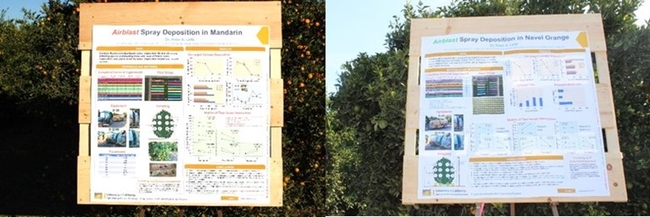
The Impact
The participants were fully engaged throughout the training. Overall, those who reported gaining “much” to “very much” learning are as follows: 87% for “Welcome, Introduction, and Purpose”; 80% for “Introduction to ‘Airblast Spray Advisor' decision support tool”; 87% for “Airblast spray demonstration”; 93% for “Spray deposition in mandarin”; 94% for “Spray deposition in navel orange”; and 87% in “Spray drift potential in citrus applications”. On average, about 85% reported learning gains in the classroom portion and about 91% reported learning gains in the field. Overall, 93% reported “much” to “very much” learning for the entire field day, showing that the training was very effective and provided participants with a great amount of learning.
Dr. Larbi and his AgAppE Program plan to continue providing similar trainings in the future on both ongoing and need bases to arm his clientele with science-based knowledge that will promote their operational efficiency and profitability.
- Author: Yu Meng
- Author: Dorina M Espinoza
- Author: Marisa Neelon
In response to CA SB1383, the 4-H Food Waste Busters Project provides an opportunity for youth to engage in reducing household food waste and help combat climate change.
The Issue
Household food waste is a major problem in the U.S. and the average U.S. household wastes 31.9% of the food it buys, with an estimated value of $240 billion. Food scraps, yard trimmings, and other organic waste make up half of what Californians add to the landfills. Greenhouse gases released by decomposing food and yard waste contribute to climate change. To respond to this issue, California is implementing statewide organic waste recycling and surplus food recovery. California's short-lived climate pollutant reduction strategy (SB1383) aims to reduce organic waste disposal 75% by 2025. This goal requires every Californian to take action. Household food waste is a complex and multifaceted issue and is affected by food-related practices (planning, shopping, storing, cooking, eating, and managing leftovers). Consumers' misunderstanding of food date labels is associated with more frequent food discards and effective educational communication is needed for consumers to understand their meaning. Educating consumers about strategies to reduce household food waste will support their compliance with SB 1383.
How UC Delivers
Extension can play a part in addressing household food waste reduction efforts. There is a call for giving children and young people a 'voice' and a 'hand' in redressing climate change. We chose to tackle this problem through the 4-H youth development program. The 4-H program is grounded in the belief that youth learn best by doing hands-on learning in a positive environment and are encouraged to take on proactive leadership roles. Increasing youth awareness and knowledge about the issue can engage them in food waste reduction and potentially influence a larger community. Youth in 4-H can highlight the issue through club projects, community service, public speaking opportunities, and civic engagement.
The 4-H Food Waste Busters Project's aim was to increase knowledge and understanding of the issue of food waste and its importance in the ecosystem. Through 4-H experiences, youth develop the knowledge, skills, and attitudes needed to live a sustainable lifestyle. This project helps youth better understand how making small changes can make a difference in their home, club, and community. As a result, youth can describe what food waste means; explain the benefit of reducing food waste; conduct a food waste audit at home; and encourage household members to adopt strategies to reduce food waste.
UC ANR Advisors adapted a food waste school curriculum developed by the World Wildlife Fund into age-appropriate, inquiry-based online lesson plans that fit the 4-H project format. Since many students were still engaged in online learning as a result of the COVID-19 pandemic this created an opportunity to focus on household-level food waste. The 4-H lesson plans provided time for team building, group agreement development, activity exploration, a capstone project, and reflection. The Advisors piloted the lesson plans with fourteen youth members through 9 weekly one-hour zoom project meetings. At the end of the pilot project, Advisors conducted a focus group with the youth to confirm that our project aims were fulfilled and to provide an opportunity for them to give feedback on the lesson plans.
The Impact
The 4-H youth were able to articulate their favorable response to the project. Youth learned about food waste's impact on the environment and strategies to reduce household waste. They shared the changes they or their family made because they participated in the project. “We realized how much food we wasted and we're trying to waste less; we are trying to have one meal of leftovers every week; we stopped cooking so much food so we don't have so many leftovers that would go to waste; we buy less food unless we really need it.” One youth shared: “This project made me realize how much food we're wasting, how much I could do about that and how much impact we're having on the world.” At the end of the project, youth completed capstone projects (poem, slide show, fact sheets) to share and educate their peers and family about food waste reduction strategies. Based on the successful pilot, we developed an online training for California 4-H project leaders. Fourteen volunteers completed project training and 78% reported that they are definitely more confident in leading this project.
Components of the 4-H Food Waste Buster's project were intentionally created to help youth identify their household level of food waste and to develop strategies to reduce overall food waste including using left-over foods. The lessons also reinforced the importance of composting food instead of throwing it away. These experiences then contributed to conversations and learning about how household level behaviors can impact local, state, national and global levels of food waste and the environmental impacts of greenhouse gases that are produced in landfills.
The 4-H Project material was shared through the volunteer training and is in the process of ANR peer review. Once published on the ANR 4-H project sheet website, volunteers and educators from California and all land-grant universities in the U.S. will have free access to our lesson plans to deliver similar projects through their Cooperative Extension 4-H programs.
Tips to Reduce Food Waste


